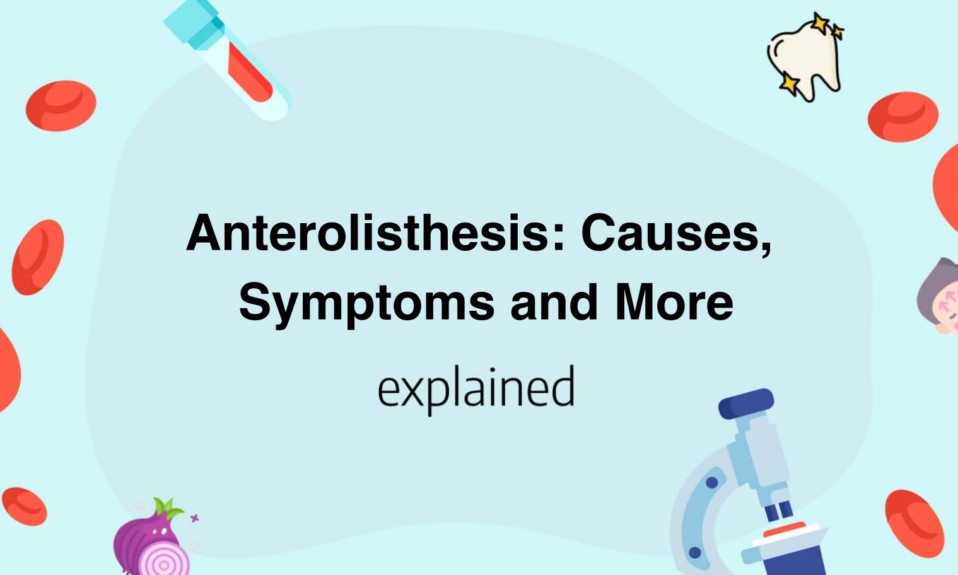Anterolisthesis is a spinal disorder that occurs when one vertebra slides forward over the one below it.
This condition can be caused by injury, degenerative spinal changes, or genetics.
Symptoms of anterolisthesis can include lower back pain, stiffness, and numbness or weakness in the legs.
Understanding the causes, symptoms, and treatment options for anterolisthesis is crucial for anyone experiencing these issues.
What is Anterolisthesis?
Anterolisthesis is a relatively common spinal health condition that can cause significant discomfort and decreased quality of life for those suffering from it.
In essence, anterolisthesis refers to when a vertebra in the spine slips forward over the vertebra below it.
This can cause a range of symptoms, including back pain, sciatica, nerve damage, and loss of mobility.
It can also be a contributing factor to other conditions, such as spinal stenosis and spondylolisthesis.
The severity of anterolisthesis can vary widely, with some patients experiencing only mild discomfort while others may require surgery to correct the issue.
There are several potential causes of anterolisthesis, including degenerative disorders, trauma, genetic factors, and spinal defects present at birth.
Additionally, certain activities and habits may increase the risk of developing this condition, such as heavy lifting, poor posture, and a sedentary lifestyle.
As such, preventative measures such as regular exercise and maintaining proper posture are crucial for maintaining spine health and reducing the risk of anterolisthesis.
Diagnosing anterolisthesis typically involves a physical exam, imaging tests such as X-rays and MRI, and potentially nerve tests to determine any damage or impingement.
Treatment options vary depending on the severity of the condition, but may include physical therapy, medication, and surgery in extreme cases.
It’s important to work with a qualified healthcare provider to determine the best course of treatment for each individual case.

Common Causes of Anterolisthesis
Anterolisthesis is a spinal condition where one vertebra in the spine slides forward over the vertebra below it.
This can occur in any part of the spine, but it is most common in the lower back.
There are several common causes of anterolisthesis, including degenerative disc disease, facet joint arthritis, and spinal injuries.
Degenerative disc disease is a condition where the discs between the vertebrae in the spine deteriorate over time.
This can cause the vertebrae to become unstable and lead to anterolisthesis.
Facet joint arthritis is a condition where the joints in the spine that allow for movement become inflamed and painful.
This inflammation can cause the bones to shift and lead to anterolisthesis.
Spinal injuries can also cause anterolisthesis, especially in cases where the injury causes a fracture or dislocation of the vertebrae.
In some cases, anterolisthesis may also be caused by congenital defects in the vertebrae or by tumors in the spine.
Symptoms of anterolisthesis may include pain, stiffness, and weakness in the back and legs.
Treatment options for anterolisthesis depend on the severity of the condition and the individual’s symptoms.
In mild cases, rest, physical therapy, and pain medications may be sufficient to manage symptoms.
In more severe cases, surgery may be necessary.
- In spinal fusion surgery, the affected vertebrae are fused together to prevent further movement and stabilize the spine.
- In laminectomy surgery, part of the affected vertebrae may be removed to relieve pressure on the nerves in the spinal canal.
Maintaining good spinal health is important for preventing anterolisthesis.
This includes maintaining a healthy weight, practicing good posture, using proper lifting techniques, and staying active.
Strengthening the muscles in the back and abdomen through exercise can also help to support the spine and prevent injury.
If you experience symptoms of anterolisthesis, it is important to seek medical attention to determine the cause of your symptoms and to develop an appropriate treatment plan.
Symptoms of Anterolisthesis You Should Know About
Anterolisthesis is a condition that occurs when a vertebra slips out of its place onto the one below it.
The severity of the slippage can vary, ranging from mild to severe.
The symptoms of anterolisthesis often depend on the degree of slippage a person has.
Many people with mild to moderate slippage may not even realize they have it until it is found on an x-ray or MRI.
However, those with more severe slippage can experience significant pain and limited mobility.
Lower back pain is the most common symptom of anterolisthesis.
This pain can be constant and range from mild to severe.
A person with anterolisthesis may also experience sciatica, which results when the slip pinches the nerve roots in the lower spine that make up the sciatic nerve.
Other symptoms of anterolisthesis can include tingling or numbness in the legs or hips, muscle weakness, and difficulty standing or walking for long periods of time.
In severe cases, anterolisthesis can even lead to bladder or bowel dysfunction.
If you experience any of the above symptoms, it is important to seek medical attention right away.
Your doctor will likely perform a physical exam, review your medical history, and may order imaging tests such as X-rays, an MRI or a CT scan to confirm the diagnosis.
Treatment for anterolisthesis depends on the severity of the condition.
Mild cases may not require any treatment at all, while more severe cases can require surgery.
Treatment options can include physical therapy, chiropractic care, medication, or surgery.
If left untreated, anterolisthesis can lead to chronic pain and permanent nerve damage, so it is important to talk to your doctor as soon as possible if you suspect you may have this condition.
Read also: Bump on Roof of Mouth: Causes And Treatment
Diagnosis and Treatment of Anterolisthesis
Anterolisthesis is a condition that occurs when one vertebra in the spine slips forward in relation to the vertebra below it, causing the spine to become unstable.
This condition can result in severe back pain, numbness or weakness in the legs, and difficulty walking.
To diagnose anterolisthesis, doctors will typically perform a physical exam and order imaging tests such as X-rays, CT scans, or MRI scans.
Treatment for anterolisthesis will depend on the severity of the condition and the location of the affected vertebrae.
For mild cases of anterolisthesis, treatment may involve rest, physical therapy, and pain management with over-the-counter or prescription medication.
Severe cases may require surgery to stabilize the affected vertebrae and alleviate symptoms.
Surgery may involve a variety of techniques, including spinal fusion or decompression surgery.
Preventing anterolisthesis involves maintaining good spinal health through regular exercise, maintaining a healthy weight, and avoiding activities that put too much strain on the back.
Good posture is also essential to prevent the condition from worsening.
Proper posture involves keeping the shoulders back, the chest forward, and the head in a neutral position.
In conclusion, anterolisthesis can be a debilitating condition that requires prompt diagnosis and treatment to alleviate symptoms and prevent further damage to the spine.
By maintaining good spinal health and seeking medical attention when symptoms arise, individuals can prevent anterolisthesis from occurring or worsening.
You’ll also like: Red Spots on Roof of Mouth: Causes
Surgery Options for Anterolisthesis
Anterolisthesis occurs when a vertebral body slips forward on the one below it.
Conservative treatment is often recommended as the first option for mild to moderate cases.
This includes physical therapy, medication, and avoiding activities that may aggravate the condition.
However, if conservative treatment fails, surgery may be necessary.
There are different surgical options available for anterolisthesis, depending on the severity and extent of the condition.
The most common type of surgery for anterolisthesis is a spinal fusion.
This procedure involves fusing two or more vertebrae together to prevent movement between them.
The surgeon may use bone grafts or implants to stabilize the spine after the fusion.
This surgery is effective in reducing pain but may limit the range of motion in the affected area.
Another surgical option is a laminectomy with or without a fusion.
A laminectomy involves removing a portion of the vertebral arch to relieve pressure on the spine.
If a fusion is performed, it is done to stabilize the spine after the laminectomy.
This surgery may be recommended for patients with spinal stenosis or nerve compression caused by the slip.
In some cases, a minimally invasive surgical approach may be used.
This type of surgery involves smaller incisions and less tissue damage, resulting in faster recovery time and less pain.
However, not all cases of anterolisthesis can be treated with minimally invasive techniques.
It is important to note that surgery should be considered as a last resort for anterolisthesis.
It is not a guaranteed solution and comes with risks and potential complications.
Patients should discuss all treatment options with their healthcare provider and make an informed decision based on their individual needs and circumstances.
- Anterolisthesis: this is the main topic of this paragraph and should be optimized for search engines to find it easily.
- Spinal fusion: is the most common type of surgery used to treat anterolisthesis, and this phrase should be highlighted to determine its importance.
- Minimally invasive surgery: is another important phrase that should be emphasized because it may interest patients.
Read also:









